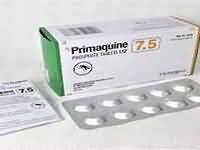CLINICAL USE
Treatment of malaria ( Plasmodium vivax and Plasmodium ovale), in combination with chloroquineTreatment of Pneumocystis jiroveci pneumonia (PCP), in combination with clindamycin
DOSE IN NORMAL RENAL FUNCTION
Malaria: 15–30 mg once daily for 14 days PCP: 30 mg once daily
PHARMACOKINETICS
DOSE IN RENAL IMPAIRMENT
GFR (mL/MIN)
DOSE IN PATIENTS UNDERGOING RENAL REPLACEMENT THERAPIES
IMPORTANT DRUG INTERACTIONS
Potentially hazardous interactions with other drugs
ADMINISTRATION
Reconstition
–
Route
Oral
Rate of Administration
–
Comments
–
OTHER INFORMATION
Primaquine base 7.5 mg is approximately equivalent to 13.2 mg primaquine phosphateMajor metabolite, 8-(3-carboxyl-1- methylpropylamino)-6-methoxyquinolone, possesses less antimalarial activity than the parent compound

